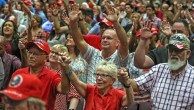Results for this survey are based on telephone interviews conducted under the direction of Princeton Survey Research Associates and Abt SRBI, Inc. among a nationwide sample of 3,016 adults, 18 years of age or older, from October 16-19, 2008 (2,264 respondents were interviewed on a landline telephone, and 752 were interviewed on a cell phone, including 267 who had no landline telephone). Both the landline and cell phone samples were provided by Survey Sampling International.
The combined landline and cell phone sample are weighted using an iterative technique that matches gender, age, education, race/ethnicity, region, and population density to parameters from the March 2007 Census Bureau’s Current Population Survey. The sample is also weighted to match current patterns of telephone status and relative usage of landline and cell phones (for those with both), based on extrapolations from the 2007 National Health Interview Survey. The weighting procedure also accounts for the fact that respondents with both landline and cell phones have a greater probability of being included in the sample.
The following table shows the error attributable to sampling that would be expected at the 95% level of confidence for different groups in the survey:
| Group | Sample Size | Plus or minus… |
| Total sample | 3,016 | 2.0 percentage points |
| Registered voter sample | 2,599 | 2.5 percentage points |
| Form 1 registered voter sample | 1,299 | 3.0 percentage points |
| Form 2 registered voter sample | 1,300 | 3.0 percentage points |
| Republican registered voter sample | 803 | 4.0 percentage points |
| Democratic registered voter sample | 953 | 3.5 percentage points |
| Independent registered voter sample | 726 | 4.0 percentage points |
| Certain McCain voters | 911 | 4.0 percentage points |
| Certain Obama voters | 1,101 | 3.5 percentage points |
| Swing voters | 587 | 4.5 percentage points |
In addition to sampling error, one should bear in mind that question wording and practical difficulties in conducting surveys can introduce error or bias into the findings of opinion polls.
